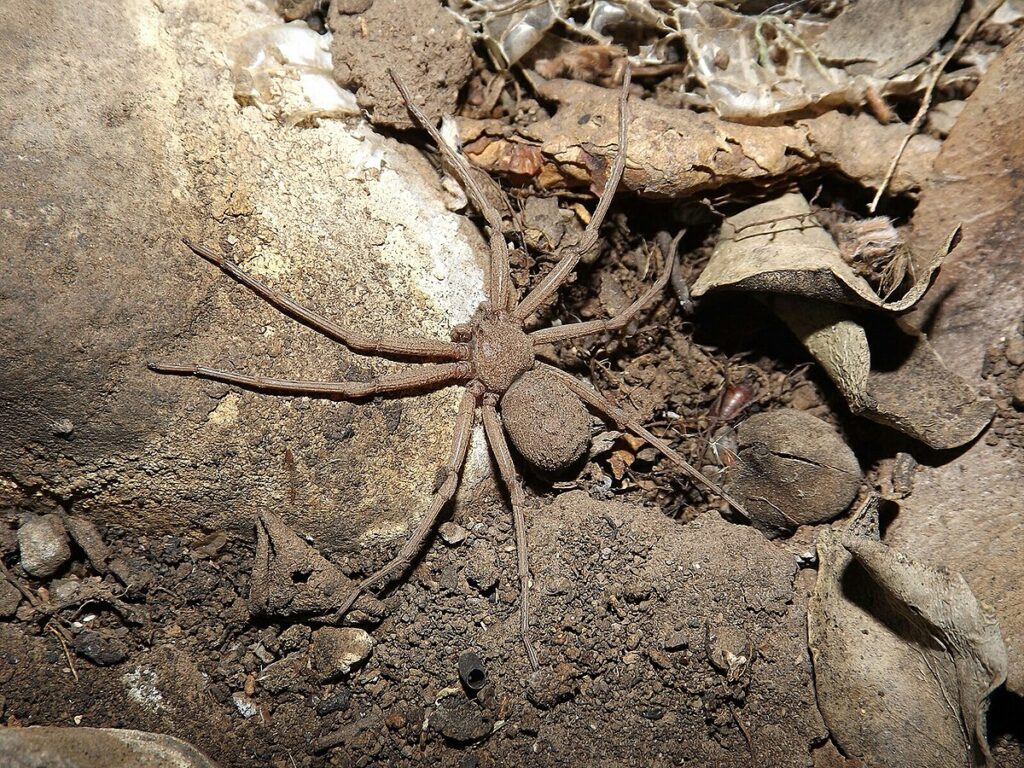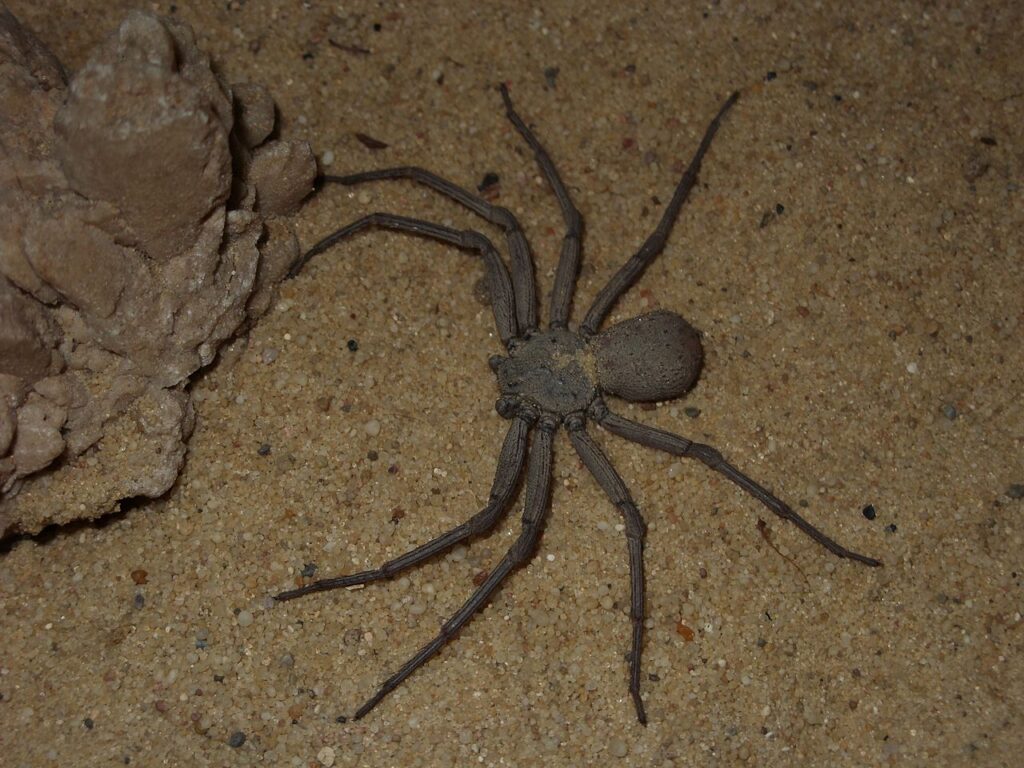Sicariidae is a family of six-eyed venomous spiders renowned for their potentially necrotic bites. This family comprises three genera and approximately 160 species. Among its most infamous members are the brown recluse spider and the six-eyed sand spider.
Loxosceles, commonly referred to as “recluse spiders” or “violin spiders,” are widely distributed across warm regions of the world. Hexophthalma and Sicarius, often called “sand spiders” or “assassin spiders,” inhabit the deserts of southern Africa and South to Central America, respectively. These spiders are known for their remarkable ability to bury themselves in sand and survive for extended periods without sustenance or water.

All members of this family possess six eyes arranged in three pairs. Violin spiders typically exhibit a brownish hue with a distinct, darker violin-shaped marking on the cephalothorax. They are haplogyne, meaning their females have unsclerotized reproductive organs.
Hexophthalma and Sicarius, by contrast, lack this violin marking and bear a resemblance to crab spiders. Alongside tarantulas, they are among the longest-lived arachnids, with some species reaching up to fifteen years in age. Most Loxosceles species have a comparatively shorter lifespan of one and a half to two years.

All genera within this family produce sphingomyelinase D or a related tissue-destroying enzyme. This venomous component is unique among spiders and is otherwise found only in a few pathogenic bacteria. While bites from most Neotropical Sicarius species do not exhibit dermonecrotic or systemic effects, the highly venomous Sicarius ornatus contains active sphingomyelinase D proteins, making its bite particularly hazardous. Recent studies have also confirmed that Sicarius thomisoides possesses venom similar to Loxosceles laeta and Sicarius ornatus, capable of inflicting severe damage in humans. Additionally, Sicarius tropicus has been reported to have both dermonecrotic and hemolytic venom.
The venom of many Sicariidae species is intensely hemolytic and dermonecrotic, capable of destroying red blood cells and causing ulcerative lesions up to an inch (25 mm) in diameter. These wounds heal slowly and, in severe cases, may necessitate skin grafts. If infection sets in, complications can become even more serious. In rare instances, venom enters the bloodstream, leading to systemic effects and organ damage. Unlike neurotoxic spider venoms, many Sicariidae venoms lack a known antivenom.
The Sicarius Spider
Imagine this: You’re on summer vacation, diligently checking off your bucket list of 100 things to do before you die. You’ve swum with dolphins, parachuted from an airplane, and even bathed in a waterfall using nothing but fruits and flowers as your shampoo and soap. That last one, though, left you feeling dirtier than before, and it took an excruciatingly long bath to rid your hair of the stench of fermenting fruit.
Now, you’ve reached number 57: overthrow a national government.
Unfortunately, things haven’t gone as planned. Most of your co-conspirators have been captured, and you’ve had no choice but to admit defeat and flee. Your escape route? A well-planned, well-provisioned journey through the desert. A stroke of genius—they’ll never expect that.
Still, a lingering unease gnaws at you. The barren landscape stretches endlessly, and you know for certain that no one is in pursuit. And yet… you can’t shake the feeling that you’re being watched. Always watched.

Could it be the dreaded Sicarius? If so, your fate is already sealed. No one escapes that elite cadre of desert assassins.
The very name sends a chill down your spine, a relief in the oppressive heat. “Sica” was an ancient dagger, a short-bladed weapon of silent killers. “Sicarius” means “dagger-man”—an assassin.
Their reputation is their pride, yet they do not announce their presence. That would be far too convenient. Instead, you’re more likely to simply… cease existing.
Sicarius is a genus of spiders native to the deserts of South America and Africa. Masterful ambush predators, they can vanish in seconds, disappearing beneath the sand with an eerie efficiency. Their flattened bodies aid in this stealth, and grains of sand cling to their backs, ensuring they remain camouflaged even when not buried.
The desert is an unforgiving place, largely devoid of life, and prey can be scarce. Sicarius spiders are built to endure; they can survive without food or water for astonishing lengths of time and may live over a decade—a remarkable lifespan, considering most spiders perish within a year or two.
When an unsuspecting victim stumbles into range, Sicarius strikes with its venomous fangs—daggers dripping with a poison as merciless as the desert itself. There is no hesitation, no wasted motion. Insects perish almost instantly. Larger prey, such as rabbits, succumb more slowly.
An infamous experiment tested the venom of S. hahni, the six-eyed sand spider. While Sicarius does not typically prey on rabbits—they are assassins, not brutes—the venom proved devastating, killing the test subjects within five to twelve hours.
The horror lies in the venom’s necrotic potency. It simply annihilates cells. A single bite leaves behind raw, open sores, as if the victim had been doused with liquid death. In rabbits, these lesions expanded to 2.5 cm (1 inch) across—larger than the spider’s own body and nearly half its leg span. The dead tissue was surrounded by deep purple bruising, sometimes spanning 10 cm (4 inches).
If the cytotoxins seep into the bloodstream, the destruction intensifies. Red blood cells are obliterated, while the heart, kidneys, and liver suffer catastrophic damage. Arteries clog. The results can be fatal. Even when death does not occur, the lingering effects are severe and long-lasting.
No antivenom exists. Fortunately, Sicarius bites are exceedingly rare. These spiders dwell in the desolate wilderness, far from human habitation. Unlike their infamous relatives, such as the brown recluse, they do not seek shelter in homes or lurk in bathrooms. Moreover, they are not particularly aggressive.
After all, a true assassin does not kill indiscriminately. There is no bravado in their craft, no careless bloodshed. A Sicarius executes its duty with precision, efficiency, and chilling professionalism. And for that, we should all be grateful.
